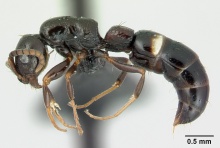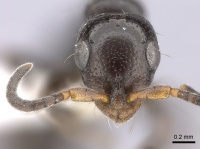Key to Tanipone Species
A key to Tanipone workers and putative ergatoid queens. Based on: Bolton, B. & Fisher, B.L. 2012. Taxonomy of the cerapachyine ant genera Simopone Forel, Vicinopone gen. n. and Tanipone gen. n. (Hymenoptera: Formicidae). Zootaxa, 3283, 1–101. PDF
1
- Dorsum of tergite of AIII with two glandular patches, one on each side of the midline. Each patch is roughly triangular to circular in shape and has sculpture or pilosity different from the remainder of the dorsum. Posterior margin of each glandular patch usually impinges upon a transverse band of off-white to yellow cuticle, or a pair of elongate off-white to yellow spots, on the posterior margin of AIII tergite . . . . . 2
- Dorsum of tergite of AIII without visible glandular patches on each side of the midline. Posterior margin of AIII tergite retains a pair of large, off-white to yellowish spots . . . . . Tanipone aglandula
2
return to couplet #1
- Glandular patches on the tergite of AIII consist of a slightly depressed area that is extremely finely shagreenate to microreticulate, or even almost smooth; without coarse, deep, densely-packed punctures that are separated by flat, densely microsculptured rims (Figs 84–85). With head in full-face view each side with a single, stout seta that projects laterally from below the outline of the eye. Side of head behind the posterior margin of the eye with a single stout seta that projects laterally, the only seta present between the posterior margin of the eye and the posterior corner . . . . . 3
- Glandular patches on the tergite of AIII consist of a mass of large, coarse, closely-packed, deep punctures. The individual punctures are separated only by narrow, flat rims, the surfaces of which are densely microsculptured and dull (Figs 82–83). With head in full-face view each side with 2–3 stout setae that project laterally from below the outline of the eye. Side of head behind the posterior margin of the eye with numerous setae of varying length that project laterally between the posterior margin of the eye and the posterior corner . . . . . 8
3
return to couplet #2
- With mesofemur in dorsal view its anterior surface has a single projecting seta that is located close to the apex. This seta is straight to slightly curved, is inclined in the direction of the femoral apex and is the only seta present on the anterior and posterior surfaces of the mesofemur. Propodeum with 1–3 pairs of setae, at least a pair present at the posterodorsal margin. On tergite of AIII a stout seta arises at, or very close to, the anterior margin of each glandular patch . . . . . 4
- With mesofemur in dorsal view the anterior surface without a projecting seta located close to the apex; anterior and posterior surfaces of mesofemur entirely without setae. Propodeum without setae. On tergite of AIII the stout seta conspicuously arises well in front of the anterior margin of each glandular patch . . . . . 6
4
return to couplet #3
- Pronotum, mesonotum and propodeum dorsally each with 2–3 pairs of setae; total number of pairs of setae on the mesosoma dorsum is always more than three (usually 6). Posterior margins of tergites of AIII and AIV each with a transverse sparse row of setae dorsally. With head in full-face view the side immediately behind the posterior clypeal margin with a single projecting stout seta. Katepisternum partially to entirely very finely and densely longitudinally striolate . . . . . Tanipone scelesta
- Pronotal dorsum with a single pair of setae, at the humeri; mesonotum with 0–1 pairs and propodeum with a single pair, at the posterior margin; total number of pairs of setae on mesosoma dorsum is 2–3. Posterior margins of tergites of AIII and AIV almost always without setae; only very rarely with one or two present. With head in full-face view the side immediately behind the posterior clypeal margin usually without a seta, but extremely rarely a small hair may be present. Katepisternum usually smooth, at most with some very feeble sculpture on part of the surface, but without longitudinal striolae . . . . . 5
5
return to couplet #4
- Tergite of AIII in dorsal view dark brown to black, the posterior margin with a pair of pale, off white to yellowish spots that are separated medially by a longitudinal strip of dark cuticle that extends to, or very nearly to, the posterior margin. In dorsal view AII shorter and broader, AIIW/AIIL 1.15–1.30. Colour of dorsal head and mesosoma variable, ranging from orange brown to blackish brown . . . . . Tanipone varia
- Tergite of AIII in dorsal view orange, the posterior margin with a continuous pale band of off-white to yellowish cuticle. Width of pale band is more or less consistent across the sclerite, except where indented by the glandular patches, and is not bisected medially by a longitudinal strip of dark cuticle. In dorsal view AII longer and narrower, AIIW/AIIL 1.09–1.11. Colour of dorsal head and mesosoma uniformly orange . . . . . Tanipone aversa
6
return to couplet #3
- Head, mesosoma and AII orange; AIII to apex of abdomen dark brown to blackish brown except for the pale apical band on AIII. Tergite of AIII broader, AIIIW 0.76 . . . . . Tanipone cognata
- Head, mesosoma and AII to apex of abdomen more or less uniformly brown to black, except for the pale apical band or spots on AIII. Tergite of AIII narrower, AIIIW 0.45–0.66 . . . . . 7
7
return to couplet #6
- With tergite of AIII in dorsal view the posterior margin with a continuous pale band of off-white to yellowish cuticle. Width of pale band is more or less consistent across the sclerite, except where indented by the glandular patches, and is not bisected medially by a longitudinal strip of dark cuticle . . . . . Tanipone zona
- With tergite of AIII in dorsal view the posterior margin with a pair of large, pale, off-white to yellowish spots that are separated medially by a longitudinal strip of darker cuticle that extends to, or very nearly to, the posterior margin . . . . . Tanipone maculata
8
return to couplet #2
- Punctures on basal third of tergite AIV broad and coarse, closely packed so that individual punctures are only separated by their narrow cuticular rims; distances between the punctures always clearly less than the puncture diameters. Side of pronotum usually distinctly more densely sculptured than anepisternum. Head averages broader and eyes located more posteriorly, CI 81–87, EP 1.92–2.28 . . . . . Tanipone hirsuta
- Punctures on basal third of tergite AIV small and shallow, most distinctly separated by flat areas of smooth cuticle; distances between the punctures mostly distinctly greater than the puncture diameters. Side of pronotum and anepisternum both unsculptured and smooth. Head averages narrower and eyes located more anteriorly, CI 76–82, EP 1.50–1.80 . . . . . 9
9
return to couplet #8
- Larger species, HW 0.89–0.97, SL 0.52–0.58, PW 0.69–0.77, AIIW 0.62–0.74, AIIIW 0.76–0.88. AII relatively more massive (AIIW+AIIL/2 = 0.63–0.72) and eyes averaging smaller, EL/HW 0.37–0.42. With anterior portion of head in oblique dorsolateral view the diagonal area between the anterior half of the eye and the posterior limit of the frontal carinae with large foveolate punctures whose diameters are greater than the distances that separate them. Humeral setae followed on pronotal dorsum by 1–2 other pairs of setae that approach their length . . . . . Tanipone pilosa
- Smaller species, HW 0.68–0.78, SL 0.38–0.42, PW 0.51–0.61, AIIW 0.44–0.59, AIIIW 0.57–0.70. AII relatively less massive (AIIW+AIIL/2 = 0.45–0.56) and eyes averaging larger, EL/HW 0.42–0.45. With anterior portion of head in oblique dorsolateral view the diagonal area between the anterior half of the eye and the posterior limit of the frontal carinae with small, scattered punctures whose diameters are less than the distances that separate them. Humeral setae not followed on pronotal dorsum by any other setae that approach their length . . . . . Tanipone subpilosa



















